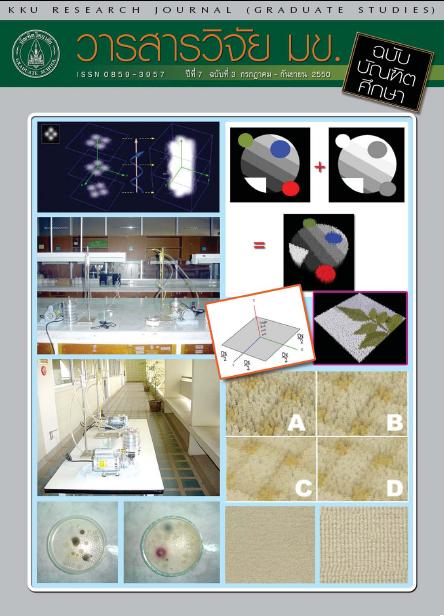Utilization of Community Forest : A Case Study of Zum Phuknam Community Forest, Chumpae District, Khon Kaen Province(การใช้ประโยชน์ป่าชุมชน : กรณีศึกษา ป่าชุมชนบ้านซำผักหนาม อำเภอชุมแพ จังหวัดขอนแก่น)
Keywords:
Utilization(การใช้ประโยชน์), Community forest(ป่าชุมชน), Species diversity of tree(ความหลากหลายของพันธุ์ไม้ยืนต้น)Abstract
การวิจัยในครั้งนี้มีวัตถุประสงค์เพื่อสำรวจการใช้ประโยชน์และประเมินมูลค่าทางเศรษฐศาสตร์ของของป่า ศึกษาการจัดการป่าชุมชน สำรวจชนิดพันธุ์ไม้ยืนต้น และวิเคราะห์โครงสร้างป่าในพื้นที่ป่าชุมชน บ้านซำผักหนาม อ.ชุมแพ จ.ขอนแก่น การสำรวจข้อมูลอาศัยแบบสอบสัมภาษณ์ โดยการเก็บข้อมูลใช้ตัวแทนครัวเรือนทั้งหมด 77 ครัวเรือน จากการศึกษาพบจำนวนครัวเรือนที่เข้าไปใช้ประโยชน์จำนวนทั้งสิ้น 47 และวิเคราะห์ข้อมูลเชิงพรรณนา ด้วยโปรแกรม SPSS for Windows สำหรับการสำรวจความหลากชนิดของพันธุ์ไม้ยืนต้น ใช้วิธี Quadrat Sampling Technique ขนาดของแปลง 40 x 40 ตร.ม. จำนวนแปลง 10 แปลง ครอบคลุมพื้นที่ทั้งหมด 10 ไร่ วิเคราะห์ลักษณะของโครงสร้างป่า ได้แก่ ความถี่ ความหนาแน่น ความเด่น ดัชนีความสำคัญ และดัชนีความหลากหลายทางชีวภาพ ผลการศึกษาพบว่า การบริหารจัดการทรัพยากรของบ้านซำผักหนาม เป็นผลมาจากความขัดแย้งระหว่างรัฐบาลกับชุมชนในเรื่องของการแย่งชิงทรัพยากรในพื้นที่ โดยลักษณะการบริหารจัดการทรัพยากรของชุมชนแยกได้ 3 ลักษณะ คือ 1) การแบ่งเขตการใช้ที่ดิน 2) จัดตั้งองค์กรชาวบ้าน และ 3) การประสานความร่วมมือระหว่างองค์กร จากการสอบถามการใช้ประโยชน์ของป่า 10 ประเภท พบว่า ประเภทของของป่าที่ชาวบ้านเก็บหามี 7 ประเภท คือ หน่อไม้ ไม้ฟืน เห็ด ผักป่า ไข่มดแดง แมลง และพืชหัตถกรรม มูลค่าผลประโยชน์สุทธิเชิงเศรษฐกิจของของป่าในป่าชุมชน มีมูลค่าเท่ากับ 645,599.34 บาท/ปี (13,736.16 บาท/ปี/ครัวเรือน) ในส่วนของการสำรวจความหลากชนิดของพันธุ์ไม้ยืนต้น พบว่า ป่าชุมชนบ้านซำผักหนามจัดเป็นสังคมป่าเบญจพรรณ พบจำนวนชนิดพันธุ์ไม้ยืนต้น 82 ชนิด จากทั้งหมด 32 วงศ์ มีค่าความหนาแน่นเท่ากับ 895.625 ต้น/เฮคแตร์ หรือ 143.3 ต้น/ไร่ ไม้เด่นคือ กระพี้จั่น (Millettia brandisian) ซึ่งเป็นไม้ที่มีค่าความสำคัญสูงสุดในพื้นที่ศึกษา เท่ากับ 49.2288 % และค่าดัชนีความหลากหลายทางชีวภาพของระบบนิเวศป่าไม้ของป่าชุมชนบ้านซำผักหนาม มีค่าเท่ากับ 6.9499
This study aims to investigate utilization of community forest at Ban Zum Phuknam, Khon Kaen Province, and its current management practices and to estimate economic values of non-timber forest products (NTFPs) harvested by villagers. The study is also to identify tree species diversity and analyze the forest structure of community forest. One representative from each 77 households was randomly selected for interview using a questionnaire, covering forest use, management practices, and NTFPs harvested. From the study, it reveals that the forestûs utilization is used by 47 households for descriptive data analysis with SPSS for Windows. Ten quadrats with a size of 40x40 m2 covering a total area of 10 Rais were used for forest structure analysis. Trees with diameters greater than 4.5 cm were identified and species diversity index was computed. From the study, community forest at Ban Zum Phuknam was initiated as a result of land use conflict between the community and governmental agencies. Community forest is being managed under three main aspects, including 1) forest zoning, 2) people organization, and 3) collaboration within the community and with external organizations. Seven types of NTFPs out of 10 types were identified being harvested by local people, which include bamboo shoots, fuelwood, mushrooms, forest vegetables, antûs eggs, insects, and plants used to make handicraft products. Net economic value of direct benefits derived from NTFPs equals 645,599.34 Baht/year or 13,736.16 Baht/household/year. According to forest structure analysis, the forest is classified mixed-deciduous vegetation with 82 trees species of 32 families. Species diversity index is 6.9499. Forest density is 895.63 trees/ha, equivalent to 143.3 tree/Rai. The species with the highest importance value is Millettia brandisian (Leguminosae-Papilionoideae, importance value index = 49.2288 %)



